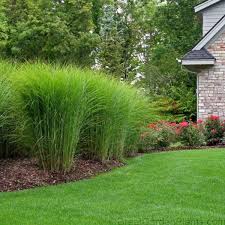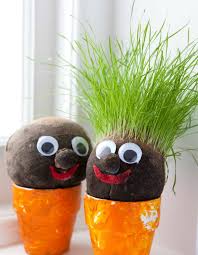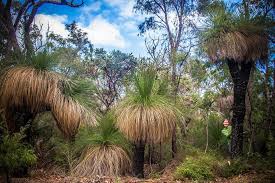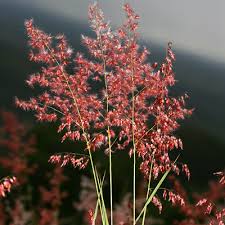Tall Decorative Grass is a kind of grass plant that grows really high and looks super nice in gardens or even near your house. These grasses are special because they aren’t like the regular grass you walk on. They’re like the fancy version of grass that can make any place look more beautiful.
When you have Tall Decorative Grass in your garden, it adds a touch of elegance and beauty. It stands tall and sways gently in the wind, which can be really soothing to watch. Some of these grasses have feathery tops that can look like fluffy clouds on sticks, while others have long, slender leaves that create a graceful movement.
You might wonder why these grasses are so popular. Well, they are quite easy to take care of, and they don’t ask for much attention. They don’t need to be watered every single day like some other plants. You just plant them in good soil, give them a bit of water, and they’ll grow happily. That’s why many people love to have them around their homes.
One cool thing about Tall Decorative Grass is that they come in many different kinds. Some have colorful leaves that change with the seasons, going from green to gold or even shades of red. This can add a lot of variety to your garden and keep it looking interesting all year round.
These grasses also play well with others. What that means is, they look really nice when you plant them with other flowers or plants. They can create a beautiful backdrop or add some height to a flower bed. It’s like they’re the tall, friendly neighbors of your garden.
Another reason people like them is because they can also give a bit of privacy. If you plant them in a row, they can act like a natural screen that blocks the view from outside. So, you can enjoy your garden without feeling like you’re on display.
But remember, even though they’re easy to take care of, they still need a bit of attention. You might need to trim them back once in a while to keep them looking neat. And if they start to spread too much, you can divide them and plant the extra parts in other places.
In addition, Tall Decorative Grass is a great choice if you want to add some beauty and elegance to your garden without too much fuss. They’re tall, they’re easy to take care of, and they come in different styles to suit your taste. So, if you’re looking to make your outdoor space more stunning, consider adding some of these lovely grasses.
Read Also: 8 Medicinal Health Benefits of Scrophularia nodosa (Common Figwort)
Uses of Tall Decorative Grasses

Tall Decorative Grass serves various purposes and can be used in different ways to enhance the beauty and functionality of your outdoor space. Here are some common uses for these grasses:
1. Ornamental Landscaping: The primary use of Tall Decorative Grass is in ornamental landscaping. They can be planted in gardens, along pathways, or near patios to add visual interest and create a soothing atmosphere with their swaying movements.
2. Privacy Screens: When planted in rows, these grasses can act as natural privacy screens, shielding your yard or outdoor space from prying eyes while still allowing a gentle breeze to pass through.
3. Accent Plants: Tall Decorative Grass can serve as striking focal points in your landscape design. Placing them strategically amidst other plants can draw attention and add a touch of drama to your garden.
4. Windbreaks: In open areas, these grasses can help break the force of strong winds, providing protection to more delicate plants and creating a more sheltered environment.
5. Erosion Control: Planting Tall Decorative Grass on slopes or areas prone to erosion can help stabilize the soil with their root systems, preventing soil runoff and preserving the landscape.
6. Cut Flower Arrangements: Some varieties of Tall Decorative Grass have feathery plumes that can be used in cut flower arrangements. These plumes add a unique texture and elegance to floral displays.
7. Habitat and Wildlife: These grasses can provide habitat and cover for small wildlife such as birds, insects, and other beneficial creatures, contributing to a healthier ecosystem in your garden.
8. Natural Sound Barrier: The rustling sound created by the leaves of Tall Decorative Grass can act as a natural sound barrier, reducing noise from traffic or neighboring areas.
9. Dried Arrangements: After the growing season, you can cut and dry the plumes of some varieties to create attractive dried flower arrangements that can be enjoyed indoors.
10. Economical Landscaping: Tall Decorative Grass can be a cost-effective way to add height and structure to your landscape, as they often require less maintenance and water compared to some other ornamental plants.
11. Restoration Projects: These grasses are sometimes used in ecological restoration projects to help reestablish native plant communities and improve the overall health of natural landscapes.
12. Green Roofs: In urban environments, some varieties of Tall Decorative Grass can be used in green roof installations to enhance the aesthetic appeal of buildings while providing some insulation and environmental benefits.
Remember that the specific uses of Tall Decorative Grass can vary depending on the species and the unique characteristics of your landscape. Whether you’re looking for visual appeal, functional benefits, or a combination of both, these grasses can offer a versatile and attractive solution for your outdoor space.
Grass Head

Grass head is a fun and simple way to grow your own little patch of grass. It’s like having your own mini garden indoors! To make a grass head, all you need is a small container, some soil, grass seeds, and a little bit of water.
To start, find a container like a small cup or a yogurt container. Fill it with soil almost to the top. Then, sprinkle some grass seeds evenly on the soil. Gently press the seeds into the soil, but not too hard.
Now comes the exciting part! Give your grass head a “haircut” by covering the seeds with a thin layer of soil. Just like you’re tucking them in for a nap. Water the soil gently, making sure it’s damp but not soaking wet.
Place your grass head in a sunny spot, like near a window. The sunlight will help your grass head grow. Keep the soil moist by giving it a little water every day. Soon, you’ll see tiny green shoots sprouting from the soil. As they grow taller, they’ll look like the hair on your grass head!
You can even get creative by decorating your grass head’s container with googly eyes, markers, or stickers to give it a unique personality. Watch as your grass head transforms into a cute and green little friend. Remember to be patient and take good care of it. Just like any living thing, your grass head needs love and attention to thrive.
Having a grass head is not just about growing something—it’s also a wonderful way to learn about plants and how they grow. It’s a perfect activity for kids and adults alike, and it brings a touch of nature into your home. So go ahead, give it a try, and enjoy the joy of watching your grass head come to life.
Grass Trees

Grass trees, also known as Xanthorrhoea, are unique and fascinating plants that are native to Australia. They have a striking appearance, resembling a cross between a tree and a grass plant. Despite their name, they are not true trees, but rather belong to the family Xanthorrhoeaceae.
These remarkable plants consist of a tall, woody stem that can reach several meters in height, topped with a clump of long, grass-like leaves that radiate from the top. The leaves are usually tough and fibrous, adapted to withstand harsh environmental conditions such as drought and wildfires. Grass trees are well-adapted to Australia’s often challenging climate.
One of the most impressive features of grass trees is their ability to live for a very long time. Some species can live for several hundred years! They have a slow growth rate, with only a few centimeters added to their height each year. This slow growth contributes to their resilience and ability to survive in harsh conditions.
Grass trees play an essential role in their ecosystems. They provide habitat and food for various wildlife, including insects, birds, and small mammals. The flowering stalk of a grass tree can shoot up from the center of the plant, producing a tall and striking flower spike. This spike is covered in small, fragrant flowers that attract pollinators like bees and birds.
Aboriginal cultures in Australia have a strong connection to grass trees. They have traditionally used various parts of the plant for food, medicine, and tools. The resin from the base of the leaves was used as a glue and as a material to attach spearheads to wooden shafts.
If you’re interested in cultivating a grass tree, keep in mind that they have specific requirements. They prefer well-draining soil and plenty of sunlight. When growing from seed, patience is key, as it can take several months for the seeds to germinate. Young grass trees can also be quite sensitive to transplanting, so care should be taken when moving them.
In addition, grass trees are remarkable plants that showcase the beauty of Australia’s native flora. Their unique appearance, adaptability to challenging conditions, and important role in ecosystems make them a captivating subject of study and admiration.
Read Also: 7 Medicinal Health Benefits of Scrophularia ningpoensis (Ningpo Figwort)
Red Top Grass

Red Top grass, scientifically known as Agrostis gigantea, is a cool-season perennial grass that is commonly found in many parts of the world, particularly in North America and Europe. It is also referred to as Redtop bentgrass due to its distinctive red-hued seedheads that develop during its flowering stage.
This grass is often found in natural and cultivated settings, such as pastures, meadows, roadsides, and lawns. It is known for its ability to tolerate a range of soil types, making it adaptable to various environments. Red Top grass is particularly well-suited for areas with moist or poorly drained soils, as it has a good tolerance for waterlogging.
One of the notable features of Red Top grass is its ornamental value. When it enters its flowering phase, typically in late spring or early summer, it produces delicate, feathery seedheads that have a reddish hue. These seedheads sway gracefully in the wind, adding visual interest to the landscape. The grass’s ability to thrive in wetter conditions also makes it useful for erosion control along waterways and in areas prone to runoff.
In terms of its uses, Red Top grass is sometimes used for forage purposes, providing grazing animals with a palatable food source. It can also be included in seed mixtures for lawns, especially in areas where maintaining a consistently lush lawn can be challenging. Additionally, its natural ability to grow in moist soils makes it an ecological asset for wetland restoration and habitat enhancement projects.
When it comes to cultivation, Red Top grass is relatively easy to establish from seed. It prefers full sun to partial shade and can tolerate a range of soil pH levels. Regular watering during its establishment phase is important, and once established, it can handle occasional flooding and waterlogged conditions.
However, it’s important to note that while Red Top grass has its merits, it can also become invasive in some regions, outcompeting native vegetation and disrupting local ecosystems. As such, it’s recommended to use this grass thoughtfully and avoid planting it in sensitive natural areas.
In conclusion, Red Top grass is a versatile and hardy grass species with distinct ornamental features. Its tolerance for wet soils and its adaptability to various conditions make it a valuable asset in landscaping, forage, and ecological restoration contexts. However, responsible planting practices are crucial to prevent its potential invasiveness in certain environments.
Read Also: E-Waste: Complete Guide to Properly Dispose your Electronic Wastes
